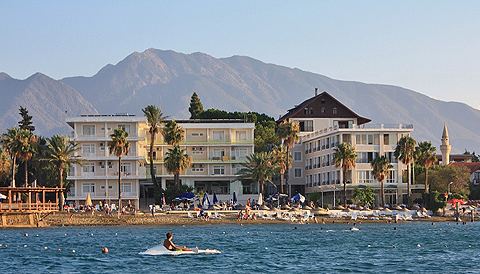Postal code 31285 Elevation 25 m Local time Saturday 12:25 PM | Time zone EET (UTC+2) Licence plate 31 Population 2,257 (2012) Area code 0326 | |
 | ||
Weather 16°C, Wind W at 5 km/h, 62% Humidity | ||
Turkey arsuz antiohia 2006
Arsuz (Arabic: أرسوز , also known as Uluçınar and formerly as Rhosus (Ancient Greek: Ῥῶσός)) is a city in Hatay Province, Turkey.
Contents
- Turkey arsuz antiohia 2006
- Map of Arsuz C4B0skenderun2FHatay Turkey
- Geography
- History
- Future district
- Episcopal see
- References
Map of Arsuz, %C4%B0skenderun%2FHatay, Turkey
Geography
Arsuz 36°24′46″N 35°53′12″E was a part of İskenderun district of Hatay Province. The town center is located 40 kilometres (25 mi) South of İskenderun and 118 kilometres (73 mi) from Antakya (administrative center of Hatay Province). The population was 2257 as of 2012. While Arsuz is technically just a small town near the end of a coastal road leading south from İskenderun, the entire coastal region between İskenderun and Arsuz is often simply referred to as Arsuz. This area is predominantly small rural farms (usually located inland towards the mountains) and small groups of summer homes (usually located near the coastline). Arsuz was declared the center of Arsuz ilçe (district) in 2012 by the Metropolian Law in Turkey.
History
Arsuz had many names throughout history, including: Rhosus, Rhossus, Rhopolis, Port Panel/Bonnel, Kabev and Arsous. The earliest documents about it date from the Seleucid Empire, of whose Antioch became the capital. Arsuz was then an important seaport on the Gulf of Issus. In 64 BC it was annexed by the Roman Empire. Under the name Rhosus, it was a ciry in the late Roman province of Cilicia Secunda, with Anazarba as its capital. It is mentioned by Strabo, Ptolemy, Pliny the Elder and Stephanus Byzantius; and later by Hierocles and George of Cyprus,
Some Christians in Rhosus accepted as truth the Docetic Gospel of Peter and for them in around AD 200 Serapion of Antioch composed a treatise condemning the book. Theodoret, relates the history of the hermit Theodosius of Antioch, founder of a monastery in the mountain near Rhosus, who was forced by the inroads of barbarians to retire to Antioch, where he died and was succeeded by his disciple Romanus, a native of Rhosus; these two religious are honoured by the Greek Orthodox Church on 5 and 9 February.
In 638 the city was incorporated into the Rashidun Caliphate. In 969 it was taken by the Byzantine Empire, in 1084 by the Seljuk Turks, in 1039 by the Crusades, in 1296 by the Egyptian Mamluks, and in 1517 by the Ottoman Turks.
Between 1918 and 1938 the town was under French Mandate for Syria and the Lebanon with the rest of Iskenderun district. In 1938 it became part of the independent Hatay Republic, but in June 1939 the Hatay legislature voted to join Turkey.
The Inhabitants are predominantly Alawites.
Future district
According to Law no. 6360, in 2014 Arsuz is to become a district. There will be seven towns and 25 villages in the rural area of the district.
Episcopal see
Six bishops of Rhosus are known:
The see is mentioned among the suffragans of Anazarba in the Notitiae episcopatuum of the Patriarchate of Antioch, of the 6th century and one dating from about 840. In another of the 10th century Rhosus is included among the exempt sees.
It is now a titular see of the Catholic church.
